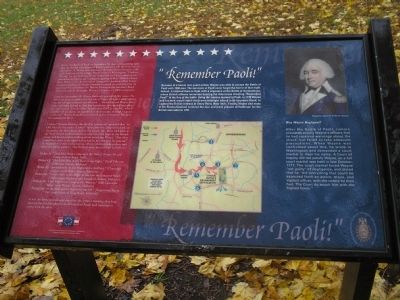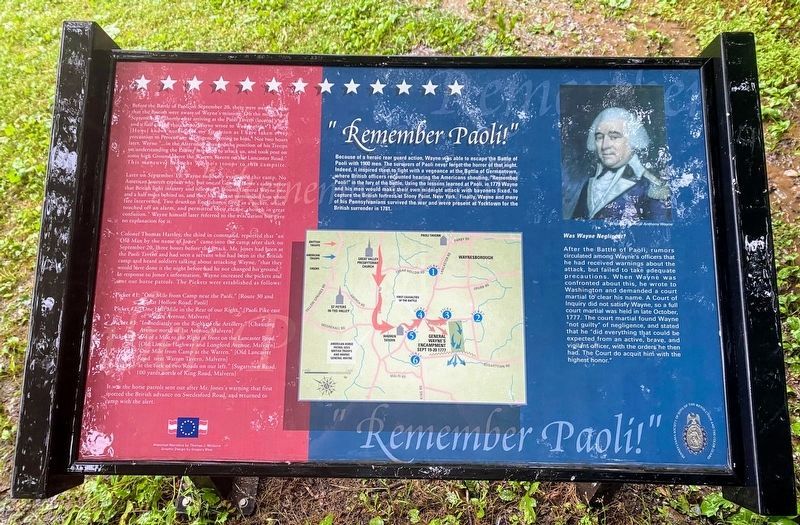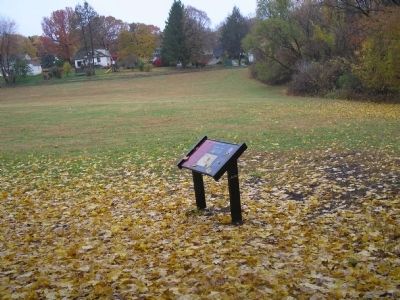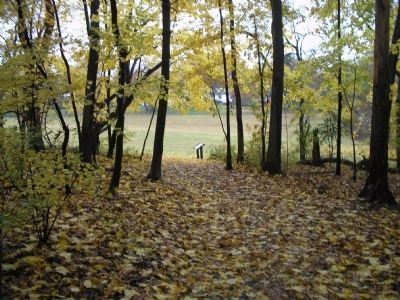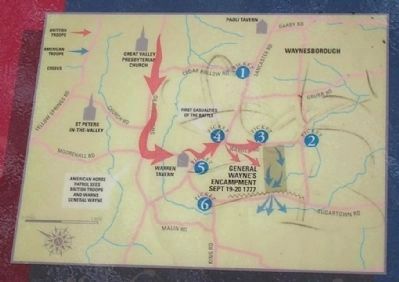Malvern in Chester County, Pennsylvania — The American Northeast (Mid-Atlantic)
“Remember Paoli!”
Before the Battle of Paoli on September 20, there were warning signs that the British were aware of Wayne’s mission. On the morning of September 19, shortly after arriving at the Paoli Tavern (located a mile and a half east of this camp), Wayne wrote to Washington, “I believe [Howe] knows nothing of my Situation as I have taken every precaution to Prevent any intelligence getting to him.” Not two hours later, Wayne “ … in the Afternoon changed the position of his Troops on understanding the Enemy intended to attack us, and took post on some high Ground above Warren Tavern on the Lancaster Road.” This maneuver brought Wayne’s troops to this campsite.
Later on September 19, Wayne suddenly evacuated this camp. No American sources explain why, but one of General Howe’s aides wrote that British light Infantry and riflemen “ … found General Wayne two and a half miles behind us, and they had almost surrounded him when fate intervened. Two drunken Englishmen fired at a picket, which touched off an alarm, and permitted their escape, though in great confusion.” Wayne himself later referred to the evacuation but gave no explanation for it.
Colonel Thomas Hartley, the third in command, reported that “an Old Man by the name of Jones” came into the camp after dark on September 20, three hours before the attack. Mr. Jones had been at the Paoli Tavern and had seen a servant who had been in the British camp and heard soldiers talking about attacking Wayne, “that they would have done it the night before had he not changed his ground.” In response to Jones’s information, Wayne increased the pickets and sent out horse patrols. The Pickets were established as follows:
Picket #1: “One Mile from Camp near the Paoli.” [Route 30 and Cedar Hollow Road, Paoli]
Picket #2: “One Half Mile in the Rear of our Right.” [Paoli Pike east of Warren Avenue, Malvern]
Picket #3: “Immediately on the Right of the Artillery.” [Channing Avenue north of 1st Avenue, Malvern]
Picket #4: “ ¾ of a Mile to the Right in front on the Lancaster Road.” [Old Lincoln Highway and Longford Avenue, Malvern]
Picket #5: “One Mile from Camp at the Warren.” [Old Lancaster Road near Warren Tavern, Malvern]
Picket #6: “at the fork of two Roads on our left.” [Sugartown, 100 yards north of King Road, Malvern]
It was the horse patrols sent out after Mr. Jones’s warning that first spotted the British advance on Swedesford Road, and returned to camp with the alert.
Sidebar: Was Wayne Negligent?
After the Battle of Paoli, rumors circulated among Wayne’s officers that he had received warnings about the attack, but failed to take adequate precautions. When Wayne was confronted about this, he wrote to Washington and demanded a court martial to clear his name. A Court of Inquiry did not satisfy Wayne, so a full court martial was held in late October 1777. The court martial found Wayne “not guilty” of negligence, and stated that he “did everything that could be expected from an active, brave, and vigilant officer, with the orders he then had. The Court do acquit him with the highest honor.”
Topics. This historical marker is listed in these topic lists: Notable Events • Notable Places • War, US Revolutionary. A significant historical date for this entry is September 20, 1777.
Location. 40° 1.827′ N, 75° 30.898′ W. Marker is in Malvern, Pennsylvania, in Chester County. Marker can be reached from Monument Avenue, on the left when traveling west. Marker is on the Paoli Battlefield. Touch for map. Marker is in this post office area: Malvern PA 19355, United States of America. Touch for directions.
Other nearby markers. At least 8 other markers are within walking distance of this marker. The Land on Which the Battle of Paoli was Fought (within shouting distance of this marker); Rear of the Camp (about 300 feet away, measured in a direct line); Camp Life (about 600 feet away); "Losing a wheel and crashing into a gap in the fence line"... (about 700 feet away); General Wayne’s Encampment (about 700 feet away); "…The most dreadful scene I have ever beheld." (about 700 feet away); “A Dreadful scene of havock” (approx. 0.2 miles away); The Paoli Battlefield (approx. 0.2 miles away). Touch for a list and map of all markers in Malvern.
More about this marker. The marker contains a map of British and American troop movements during the Battle of Paoli. General Wayne’s encampment, the American pickets, the site of the first casualties of the battle and where the American horse patrol spotted the British are indicated, as well as prominent nearby buildings.
The marker also features a portrait of Brigadier General Anthony Wayne.
Related markers. Click
here for a list of markers that are related to this marker. This series of markers follow the walking trail of the Paoli Battlefield.
Also see . . .
1. The Battle of Paoli (Massacre) September 21, 1777 at Malvern, Pennsylvania. The American Revolutionary War website. (Submitted on November 16, 2008, by Bill Coughlin of Woodland Park, New Jersey.)
2. The Battle of Paoli also known as the Paoli Massacre. A British perspective of the battle from BritishBattles.com (Submitted on November 16, 2008, by Bill Coughlin of Woodland Park, New Jersey.)
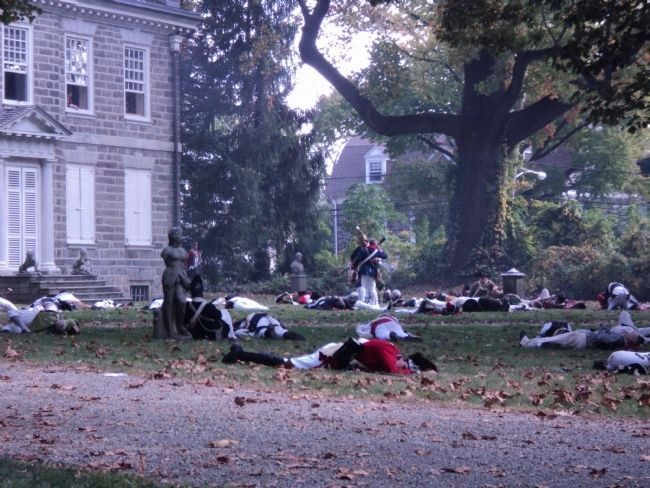
Photographed By Bill Coughlin, October 5, 2013
6. British Dead at the Battle of Germantown
The troops of Gen. Anthony Wayne used the rallying cry “Remember Paoli!” during the October 4, 1777 Battle of Germantown. British dead from that battle are seen here at the Chew mansion, which saw some of the fiercest fighting of the battle.
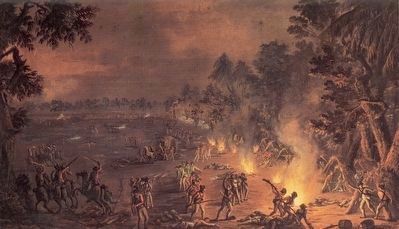
Oil by Xavier Della Gatta via Wikipedia Commons, 1782
7. “A Dreadful Scene of Havock”
This painting depicts the British light infantry and light dragoons attacking the Continental Army encampment at Paoli on 20 September 1777. The picture was painted in London and was commissioned for a British Army officer who had participated in the battle, possibly a Lieutenant Martin Hunter of the 52nd Regiment of Foot.
Credits. This page was last revised on May 19, 2021. It was originally submitted on November 16, 2008, by Bill Coughlin of Woodland Park, New Jersey. This page has been viewed 1,607 times since then and 46 times this year. Photos: 1. submitted on November 16, 2008, by Bill Coughlin of Woodland Park, New Jersey. 2. submitted on May 12, 2021, by Shane Oliver of Richmond, Virginia. 3, 4. submitted on November 16, 2008, by Bill Coughlin of Woodland Park, New Jersey. 5. submitted on November 17, 2008, by Bill Coughlin of Woodland Park, New Jersey. 6. submitted on October 8, 2013, by Bill Coughlin of Woodland Park, New Jersey. 7. submitted on September 19, 2015, by J. J. Prats of Powell, Ohio.
